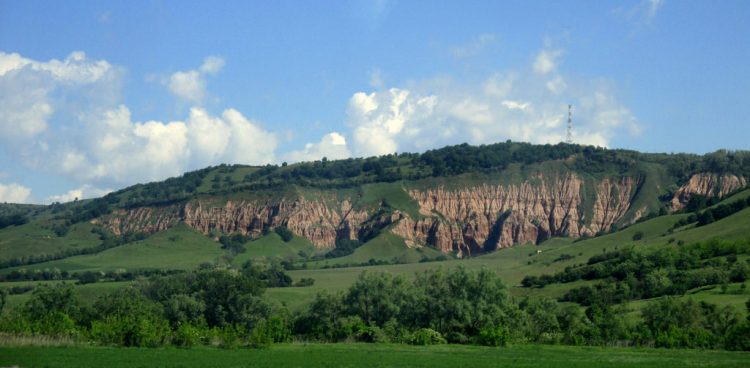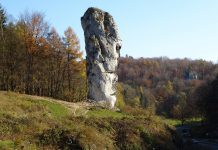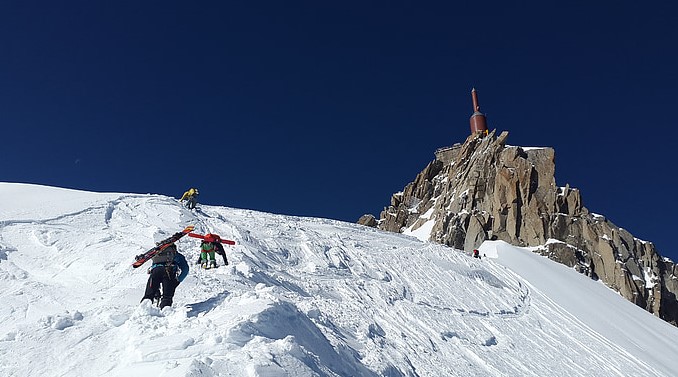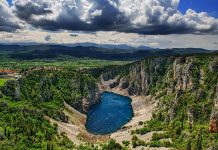Romania’s interruption by a jagged red anomaly is guarded by the steep walls of the Râpa Roșie (Red Ravine). This is a natural geological reserve on the southwesterly part of the Secaşelor Plateau. Râpa Roșie is a protected area in Alba County, Romania. It is a geological and botanical reserve with a size of approximately 24 hectares; the reserve is classified as IUCN Category III.
Erosion and runoff have given it a prominent appearance on the mountainside. The water has carved deep into the gravel, sandstone, and quartz of the plateau’s sublayer, creating unusual natural spiked towers and pyramid shapes in the red clay. When the water falls into the ravines, it makes a roaring sound.
The result is frequently compared to the Grand Canyon; however, it’s not quite as huge. Râpa Roșie measures stretch over a length of 800 meters. Rapa Rosie’s tallest peaks are about 300 feet. Over the last 60 million years, it has also been ever-evolving, torrential rains have caused obvious changes to the folds in the exclusively steep slopes. Tiered columns and pyramids, separated by ravines, form a badlands microrelief. Specialized studies showed there are 145 plant species in 41 families, and 8 endangered species are characteristic of this area.
In 1865, the first archaeological exploration made by Fr. W. Schuster, revealed remnants of large and small pottery that had ornamentation, which also attested to the Coţofeni culture. The Red Ravine remains relatively unidentified, even to those who have lived nearby for years. There are local tales of World War I soldiers passing through the red ravine in order to get to Alba Iulia.
At the end of the war, representatives declared the union of Transylvania and Romania. There are many other natural attractions nearby, archaeological excavations were carried out here, and the remains of Coţofeni culture were found, as well as dinosaur bones from the early Miocene period (15–23 million years ago).
The geological monument is easily called a natural wonder due to gravel, quartz sands, and sandstones. The deposits are a distinct succession of red clays, gray and reddish soapstones, and friable white soapstones. The area is home to numerous rare and endemic plants. Also, many of the of the largest caves in the world were declared natural monuments.
In spite of its obscurity and consequential lack of visitors, the ravine remains in beautiful shape. Râpa Roșie is one of the major tourist attractions in Alba County, but it is also one of the most notable natural monuments in Romania and a European rarity. This is really a cool place to explore in the afternoon.
Also, Read Maletsunyane Falls! An Awesome Natural Phenomena





Source: Atlas Obscura ! Wikipedia
Product You May Be Interested in
- Cat Spraying No More – How to Stop Your Cat from Peeing Outside the Litter Box – Permanently.
- High-Quality Dog Training Course Featuring 21 Games to Improve your Dog’s intelligence & Behavior with Professional Dog Trainer.
- Flavor Pairing Ritual Supercharges Women’s Metabolisms
- The best Keto Diet Program
- Boost Your Energy, Immune System, Sexual Function, Strength & Athletic Performance
- Find Luxury & Designer Goods, Handbags & Clothes at or Below Wholesale
- Learn How To Build A 3d Solar Panel Converts Like Crazy, and Save Lot of Money?
- Unlock your Hip Flexors, Gives you More Strength, Better Health and All-Day Energy.







